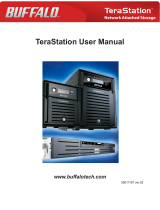3
Method 2-Mapping a Network Drive using the Flash Map Windows utility from the Setup CD.........................18
Method 3- Accessing the NAS storage via Web Interface ...................................................................................20
C. Changing Password.........................................................................................................................................20
Chapter 5 ADMINISTRATION SETUP ............................................................................................................................22
A. Web Administration Setup .............................................................................................................................22
B. Users Screen ...................................................................................................................................................22
C. Status Screen ..................................................................................................................................................25
D. Network Screen ..............................................................................................................................................26
E. System Screen ................................................................................................................................................28
F. Media Screen..................................................................................................................................................32
Chapter 6 ADVANCED ADMINISTRATION SETUP.........................................................................................................34
A. Overview.........................................................................................................................................................34
B. Groups Screen ................................................................................................................................................34
Groups-Access Screen..........................................................................................................................................35
Groups-Members Screen.....................................................................................................................................36
C. Shares Screen .................................................................................................................................................37
Shares-Access Screen...........................................................................................................................................38
D. Backup Screen ................................................................................................................................................39
Backup-Backup Job Screen ..................................................................................................................................40
Backup-Status Screen ..........................................................................................................................................41
E. Disk Screen .....................................................................................................................................................42
F. Upgrade Screen ..............................................................................................................................................45
Chapter 7 DOWNLOAD MANAGER ..............................................................................................................................46
A. Overview.........................................................................................................................................................46
The Web-base Download Management Interface ..............................................................................................46
B. Download Manager Screen ............................................................................................................................47
Download Manager – Add New Task Screen.......................................................................................................48




















